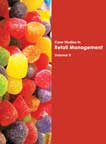Retail Management
 |
Details
Textbook:
Pages : 487;
Paperback;
210 X 275 mm approx.
Pricing
Textbook Price: Rs. 900;
Available only in INDIA
Detail Table of Contents
Click below to view
HTML
PDF
Buy Now
Please allow 5 to 10 days for delivery.
Detail Table of Contents
Merchandise Purchasing : Chapter 10
SUMMARY:
Retailers can source their merchandise from manufacturers or produce their own store brands (referred to as private labels). Both manufacturer's brands and private labels have their own advantages. Selecting brands and choosing a branding strategy are components of a retailer's process of merchandise assortment planning. The most complex task for a retailer is to decide whether to source the merchandise from within the country or to source it from global sources.
|
|
of merchandise. The retailer can consider different sources of supply: raw-resource producers, manufacturers, wholesalers and resident purchasing offices.
The second step in the merchandise purchasing process involves contacting the various sources of supply. Both the vendor and the retailer can initiate the contact process. Contacts initiated by vendors involve store visits by vendors' sales personnel or mail or telephone inquiries. Contacts initiated by retailer include visiting central markets, resident purchasing offices, and merchandise trade shows, and making telephone and mail inquiries.
The third step in the merchandise purchasing process deals with the evaluation of several prospective vendors. Retailers evaluate vendors on the basis of a) suitability, availability and the adaptability of the merchandise being offered, b) the exclusiveness of the merchandise offered and the vendor's distribution policies, c) the appropriateness of the vendor's price, d) the type and amount of promotional support offered by the vendor, and e) the type and amount of additional services provided by the vendor. Retailers can use a weighted rating method to evaluate vendors.
The fourth step in the merchandise purchasing process involves negotiating with the sources of supply. Retailers usually negotiate on price and service issues. Retailers should also consider the various transportation and handling issues that influence the cost of sourcing new merchandise.
In the fifth and final step of the merchandise purchasing process, the actual purchasing takes place. Retailers can purchase all the merchandise from a few vendors or from a number of different suppliers. They can also choose from different purchasing methods like regular, consignment, memorandum, approval or specification.
The merchandise handling process is as important as the merchandise purchasing process. This process involves developing a plan to get the merchandise carefully into the store and place it on the shelves for sale. Merchandise handling includes processing, receiving and storing merchandise, pricing and marking the inventory, arranging displays and on-floor assortments, customer transactions, delivering the goods, handling the goods that are returned by customers, taking decisions regarding damaged merchandise, and finally, controlling and monitoring losses due to merchandise pilferage.
Once a retailer develops a strategy for handling merchandise, a reorder procedure must be developed. This procedure depends on various factors like the time taken by the retailer to process the order, the time taken by the vendor to fulfill the order, the inventory turnover rate, the financial expenditure and the cost of holding inventory versus the cost of ordering merchandise. The retailer should re-evaluate the complete merchandising process periodically.
The hundreds of transactions that take place between retailers and vendors can give rise to a number of ethical and legal issues. These issues must be addressed by both retailers and vendors.



